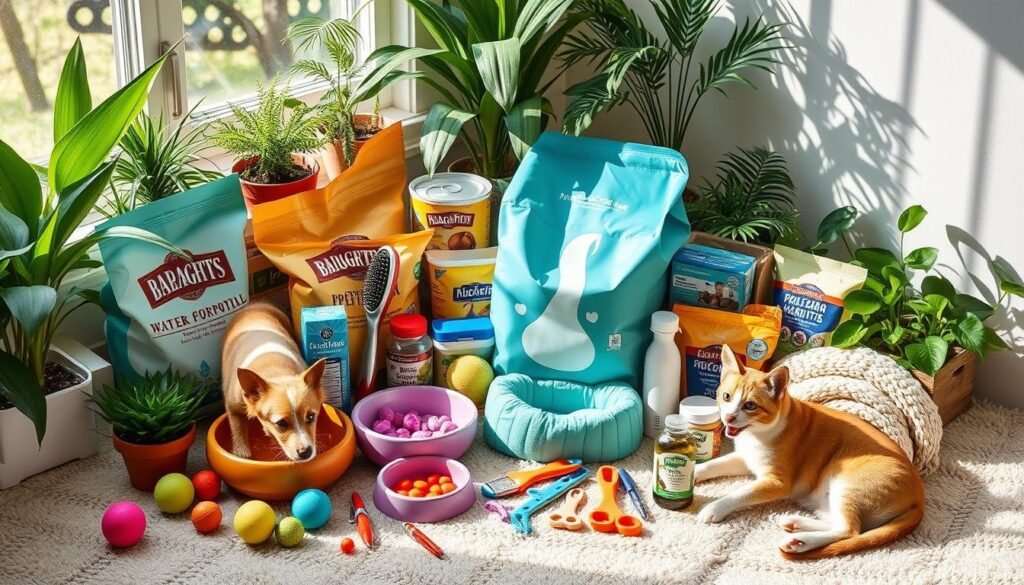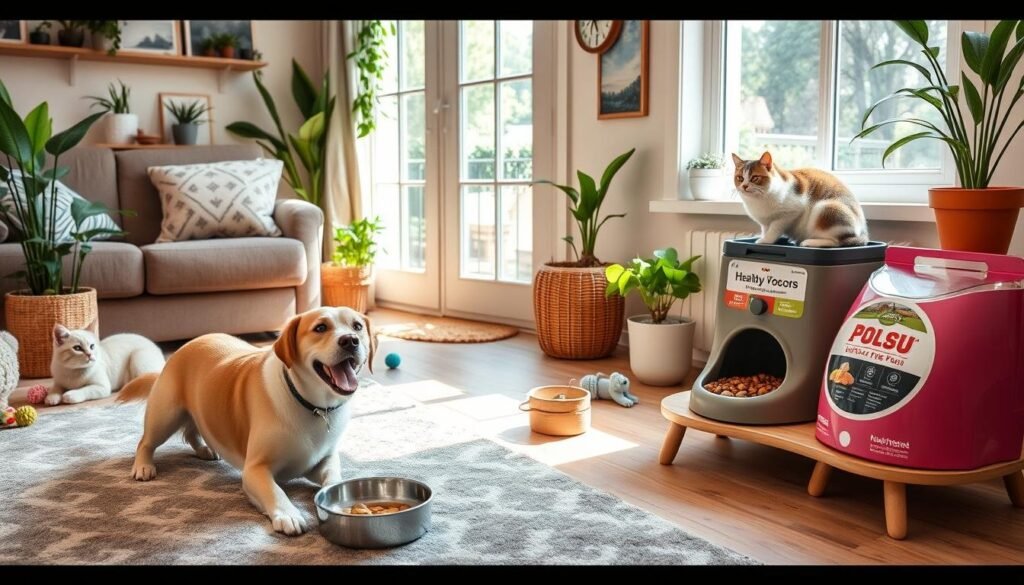Keeping pets happy and healthy at home needs a lot of care and the right tools. Good pet care makes pets happy and keeps them healthy. The American Veterinary Medical Association says regular care is key for pets. The Humane Society of the United States offers detailed tips to make pets happy.
Choosing the right pet essentials and understanding each pet’s needs is important. These tips help create a loving home for pets.
This section will focus on nutrition, exercise, and vet care. These are the main things that keep pets healthy and happy at home.
Key Takeaways
- Understanding unique needs is essential for happy pets.
- Gathering the right pet essentials enhances pet care.
- Regular vet visits are crucial for maintaining health.
- Nutrition and exercise are fundamental for pet well-being.
- A safe and engaging home environment promotes happiness.
Understanding Your Pet’s Needs
Every pet has its own special needs to be happy and healthy. Knowing what these needs are is key. It helps create a happy pet that thrives in its home.
Recognizing Different Species’ Requirements
Pets from different species have different needs. Dogs need walks and friends, while cats like to climb. Small animals like hamsters or rabbits need special homes.
By understanding these needs, pet owners can make their pets feel comfortable and safe.
The Importance of Breed-Specific Care
Breed-specific care is crucial for pets. Dogs and cats of different breeds have unique traits. These include energy levels, moods, and what they like to eat.
For example, active breeds like Border Collies need lots of exercise. Tailoring care to these needs makes pets happier and healthier.

Essential Pet Supplies Guide
Knowing the right supplies for pets can make a big difference in their comfort and care. This guide helps you find the must-have items for different pets. It ensures each animal gets what it needs to live well.
Must-Have Supplies for Dogs
Having a dog means taking on many responsibilities. This includes getting the right supplies. Here are some key items to think about:
- Collars and leashes for safe walks
- Food and water bowls for hydration and nutrition
- Toys to keep them entertained and engaged
- Grooming tools for regular maintenance
Must-Have Supplies for Cats
Cats need specific supplies to stay healthy and happy. Here are the essentials:
- Litter boxes for hygiene
- Scratching posts to maintain claw health
- Interactive toys for mental stimulation
- Cat carriers for safe transportation
Other Pets: Supplies for Small Animals
Small animals, like rabbits and guinea pigs, also need special supplies. Here are the important ones:
- Habitats to provide a safe and comfortable living space
- Bedding for warmth and comfort
- Safe chew toys to promote dental health

How to Keep Pets Healthy at Home
To keep pets healthy at home, focus on their diet and exercise. It’s important to follow pet nutrition guidelines. This ensures a balanced diet for each pet’s needs. Regular exercise also boosts their health and prevents diseases.
Nutrition Guidelines for a Balanced Diet
A balanced diet is key for pets to stay healthy. Different pets need different foods. Choose high-quality food that meets standards from organizations like The Association of American Feed Control Officials.
Consider the pet’s age, allergies, and health when choosing food. Following these guidelines helps prevent obesity and nutritional problems. This ensures pets live long, happy lives.
Regular Exercise: Maintaining Physical Health
Regular exercise is crucial for pets’ health. It keeps them physically fit, manages weight, and boosts mood. Daily walks, play, and brain games are great for their body and mind.
The Centers for Disease Control and Prevention say exercise reduces anxiety and improves heart health. It also strengthens muscles and joints. Mix up activities to keep pets engaged and meet their energy needs.

| Pet Type | Recommended Daily Exercise | Ideal Nutritional Focus |
|---|---|---|
| Dogs | 1-2 hours | High-quality protein and whole grains |
| Cats | 30-60 minutes | High-protein, low-carbohydrate options |
| Rabbits | 3-4 hours | Fresh hay, greens, and pellets |
| Birds | 1-2 hours | Seeds, fruits, and vegetables |
By following these guidelines, pet owners can keep pets healthy at home. This ensures pets lead happy, fulfilling lives.
Creating a Safe Environment for Pets
It’s crucial to make a safe space for pets. Pet-proofing your home lowers risks and makes areas where pets can relax. By following pet safety tips, you can create a caring home for your pets.
Pet-Proofing Your Home
Pet-proofing means checking your home for dangers. Begin by securing items that could harm pets. For instance:
- Storing cleaning supplies and chemicals out of reach
- Covering electrical cords to prevent chewing
- Ensuring small objects are placed high enough to avoid ingestion
Also, using safety gates can help keep pets out of certain areas. Regular checks on furniture and decorations for loose parts or sharp edges also boost pet safety. Getting pet-proofing products, like corner protectors, adds extra safety.
Safe Spaces and Comfort Areas
It’s key to have special comfort areas for pets. These spots let pets have a break when needed. For example, a cozy bed in a quiet spot or a pet crate can make pets feel safe. Here are some ways to create these areas:
- Choosing soft bedding and familiar toys
- Minimizing noise and disturbances in these zones
- Providing access to natural light through windows
By setting up a safe and cozy environment, pet owners can reduce stress and make their pets happier.
Pet Grooming and Wellness Advice
Grooming is key to keeping pets healthy. It makes them look good and stay well. Knowing the benefits of grooming is crucial for pet owners.
The Benefits of Regular Grooming
Regular grooming has many perks, including:
- Reducing shedding and minimizing pet dander in the home.
- Preventing matting, which can lead to painful skin conditions.
- Allowing owners to check for potential skin problems or abnormalities.
- Enhancing circulation and promoting healthy skin
These benefits of grooming greatly improve a pet’s health and comfort.
Basic Grooming Techniques for Home
Home grooming is easy for pet owners. Key steps include:
- Brushing: Brush your pet regularly to remove loose hair and prevent tangles.
- Bathing: Bathe your pet with pet-friendly shampoos every 4-6 weeks.
- Nail trimming: Trim nails every 3-4 weeks to keep them healthy. Be careful not to cut the quick.
Using these simple home grooming techniques makes pets happier and healthier. Grooming not only keeps pets clean but also strengthens the bond between pet and owner.
Pets: Recognizing Signs of Stress and Anxiety
It’s key for pet owners to know the signs of stress in pets. Pets can feel anxious, showing behaviors that mean they need help. Spotting anxiety early can stop more emotional pain. This part will look at common stress signs in pets and how to help them feel safe.
Common Stress Indicators in Pets
Pets show many signs when they’re stressed or anxious. Some common behaviors to watch for include:
- Excessive barking or vocalization: This can mean they’re uncomfortable or scared.
- Hiding or retreating: They might look for safe spots when feeling anxious.
- Changes in appetite: Eating too little or too much can show they’re upset.
- Restlessness: Pacing or trouble settling can mean they’re not comfortable.
- Destructive behavior: Chewing or scratching can be a way to deal with anxiety.
How to Help Pets Feel Secure
It’s important to help pets feel emotionally well. Owners can do several things to reduce stress and make pets feel safe:
- Designate a safe space: Give a cozy spot with familiar things for them to go to.
- Engage in routine playtime: Regular play helps build a strong bond and trust.
- Consider calming products: Things like anxiety wraps or pheromone diffusers can calm stressed pets.
Pets do best when they feel secure and understood. By recognizing stress signs and taking action, owners can help their pets be emotionally healthy and happy.
Routine Veterinary Care
Regular vet visits are key to keeping pets healthy. They help spot health problems early. Since pets age faster, seeing the vet every year or two is a must. These visits let vets check pets’ health and give needed care.
Importance of Regular Check-Ups
Regular vet visits build a strong bond between pets and their vets. They also keep pets healthy. Vets do many things during these visits, like:
- Physical exams to find illness signs
- Weight checks
- Dental checks
- Advice on food and exercise
Sticking to a pet check-up schedule is vital for pets’ health and happiness.
Vaccination Schedule and Preventive Care
Getting pets vaccinated on time is key to keeping them safe from diseases. Vets set the right vaccination schedule for the best protection. Along with vaccines, other preventive pet care steps are important, like:
- Flea and tick control
- Dental cleanings
- Deworming
These steps not only keep pets healthy but also help them live longer. It’s crucial for pet owners to keep up with vaccination schedules and talk often with their vet.
| Type of Care | Frequency | Purpose |
|---|---|---|
| Wellness Check-Ups | Annual | Overall health assessment |
| Vaccinations | Annual/Bi-annual | Prevent disease |
| Dental Cleaning | Every 6-12 months | Prevent dental issues |
| Flea/Tick Prevention | Monthly | Parasite control |
Following a routine vet care plan makes pets’ lives better and gives owners peace of mind.
Engaging Activities for Happy Pets
Keeping pets entertained is key for their happiness and health. Fun games for dogs and interactive cat toys are great. They make pets happy and help owners bond with them.
Fun Games for Dogs
Dogs love playing games that make them run and think. Here are some fun ones:
- Fetch: A classic game that encourages running and retrieving, offering both exercise and fun.
- Agility Drills: Set up an obstacle course in the backyard or at a local park, involving jumps, tunnels, and weave poles.
- Hide and Seek: A fantastic way to engage a dog’s natural instincts. Hide treats or toys around the home for them to find.
- Tug-of-War: Use a sturdy rope or dog toy to promote strength and playfulness, ensuring safe play to avoid aggression.
Interactive Toys for Cats
Cats need fun activities too. Interactive cat toys keep them entertained for hours. Here are some good ones:
- Laser Pointers: A simple yet effective toy that gets cats moving and pouncing while tracking the light.
- Feather Wands: These toys promote exercise and mimic hunting, satisfying their instinctual behaviors.
- Automated Rolling Balls: Battery-operated toys that move unpredictably can entice cats to chase and play.
- Interactive Puzzles: Encourage mental stimulation as cats solve challenges to receive hidden treats.
Adding these activities to your pet’s daily life can make them happier and healthier. Fun games and toys keep pets active and happy. This makes everyone, pets and owners, enjoy each other’s company more.
Conclusion
Ensuring pets are happy and healthy requires understanding their needs. It’s important to know what different pets need and how to care for them based on their breed. This knowledge helps owners build strong bonds with their pets.
Providing the right supplies is also key to a pet’s comfort. Regular vet visits, including vaccinations and health checks, are crucial for their well-being. These steps help create a nurturing environment for pets, leading to a longer, healthier life.
Engaging in fun activities is essential for pets’ physical and mental health. Playtime and social interaction strengthen emotional bonds and boost happiness. By following these tips, owners can make their pets’ lives fulfilling and ensure they stay happy and healthy every day.
FAQ
What are some essential pet supplies every pet owner should have?
Every pet owner needs food and water bowls, collars, and leashes for dogs. Cats need litter boxes and scratching posts. For small animals, you’ll need proper habitats and safe toys.
How can I keep my pets healthy at home?
Keep pets healthy by giving them a balanced diet and regular exercise. Play and walks are great. Also, don’t forget to schedule vet visits to catch health issues early.
What are common signs of stress and anxiety in pets?
Signs of stress include barking too much, hiding, and changes in eating habits. Destructive behavior is another sign. Create a safe space to help them feel better.
How often should I groom my pet?
Grooming depends on your pet’s type and breed. Long-haired pets might need grooming every few days. Short-haired pets can go weekly. Grooming keeps them clean and healthy.
What types of activities can I do with my pets to keep them engaged?
Play fetch or tug-of-war with dogs. Use interactive toys for cats. Try setting up agility courses. Variety keeps pets happy and strengthens your bond.
What is the importance of routine veterinary care for pets?
Routine vet visits are key for pets’ health. They help catch health problems early. Staying current on vaccinations and treatments keeps pets safe from diseases.
How can I create a safe environment for my pets at home?
Make your home safe by securing hazardous items and covering electrical cords. Keep small objects away and provide cozy spots for pets to retreat.
What are some nutrition guidelines I should follow for a balanced diet for my pets?
Choose high-quality pet food that fits their needs. Feed the right amount based on their size and activity. Always check with a vet for dietary advice.
